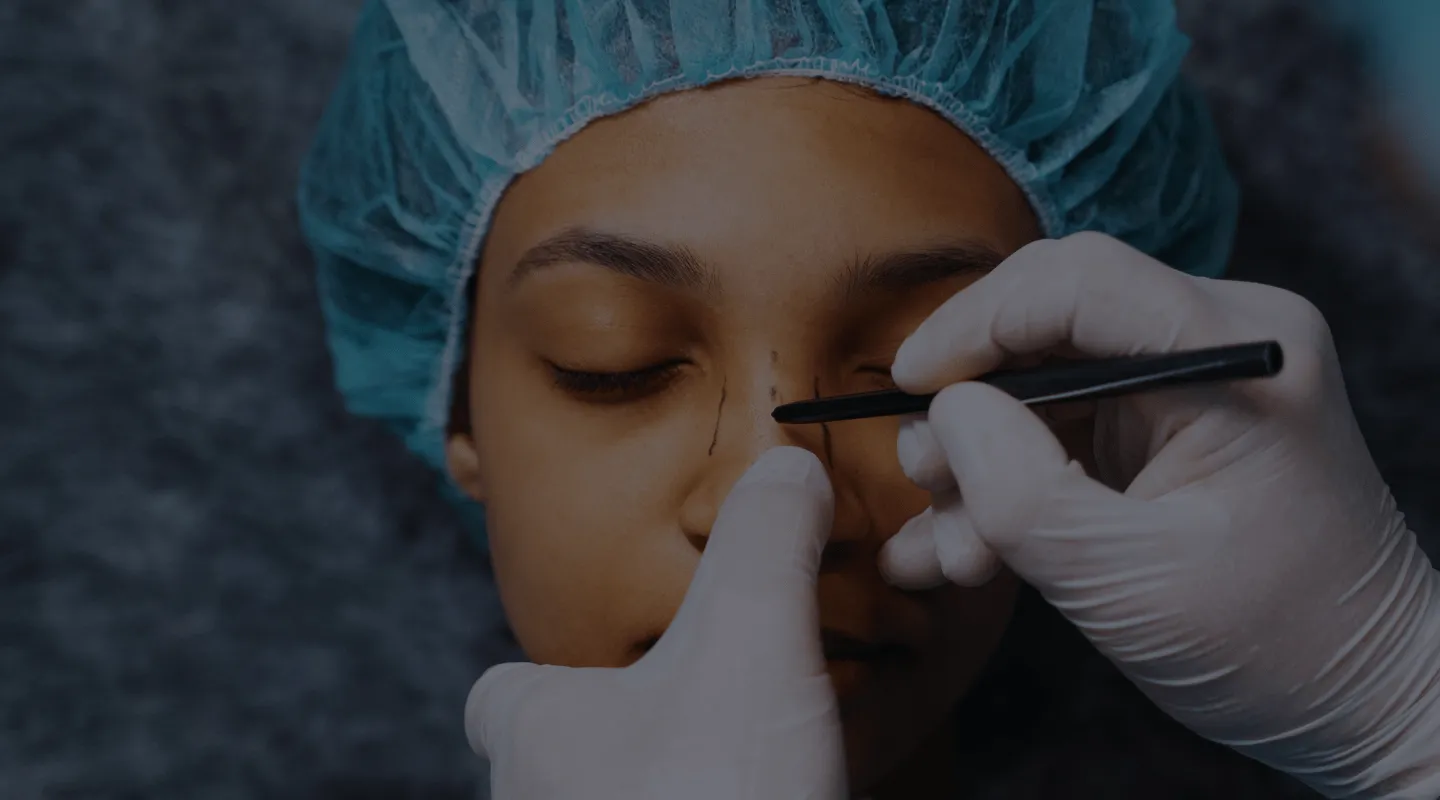
Rhinoplasty
Your Rhinoplasty in Tunisia at an Affordable Price
Because a small change can change everything, subtly enhance your profile.
How does it work?
What is Rhinoplasty?
Rhinoplasty, also known as a nose reshaping surgery, is one of the most sought-after procedures in cosmetic surgery. Rhinoplasty allows you to modify the shape and size of your nose, improving facial harmony without altering its physiognomy. More specifically, cosmetic nose surgery allows you to increase or decrease the size of the nose (too small, too large or too wide), modify the shape of the bridge of the nose (bump) and the tip (too wide, too narrow or too long), modify the width of the nostrils and change the angle between the forehead and the nose or between the nose and the upper lip. This operation can be performed on all nose shapes.
How much does a rhinoplasty cost in Tunisia?
In general, the price of rhinoplasty can vary from a few thousand to several thousand euros or dollars. However, it is essential not to choose a surgeon solely based on the price. The quality of care, the surgeon’s experience and the results obtained are equally important factors to consider. The price of nose surgery varies depending on many factors and may vary from one surgeon to another. It is essential to consider the surgeon’s reputation, experience and results, as well as the quality of care, in addition to the price, when making a decision. Do not hesitate to consult several surgeons and ask detailed questions about the costs and services included before making a final decision.
For those with a broken nose, free rhinoplasty may be an option, but this often depends on local health policies and insurance. In addition, the price of cosmetic nose surgery and rhinoplasty can also vary depending on the complexity of the procedure and the patient’s specific needs. In short, it is important to understand the cost of rhinoplasty and to discuss it in detail with your surgeon to obtain a precise and complete estimate.
Primary rhinoplasty or secondary rhinoplasty?
Rhinoplasty is defined as primary when it is performed for the first time to correct congenital or acquired imperfections. Secondary rhinoplasty, on the other hand, eliminates defects not corrected during the first operation. Sometimes, some patients must undergo another surgical procedure (tertiary rhinoplasty, quaternary rhinoplasty, etc.) due to the extent of the trauma suffered or the severity of the malformation from which they suffer (cleft lip and palate, etc.).
What is Ethnic Rhinoplasty?
Ethnic rhinoplasty is for patients of Asian, African or African-American origin who wish to Westernize their features. Ethnic rhinoplasty is particularly complex cosmetic surgery because patients of Asian, African and African-American origin have skin, conformation and consistency of osteo-cartilaginous structures different from those of patients of Caucasian origin.
What are the different rhinoplasty techniques in Tunisia?
Closed Rhinoplasty
Closed rhinoplasty is indicated for noses with small defects, especially at the tip, or that do not have large deviations of the nasal pyramid. With this technique, it is possible to correct the defects of the nose very well, which, however, must not present large asymmetries. In closed rhinoplasty, all incisions are made inside the nose. The surgeon operates using a frontal light and all modifications to the nasal pyramid are made through the nostrils. This technique is particularly difficult and is only used by very experienced surgeons.
Open Rhinoplasty
“Open” rhinoplasty is easier to perform because it allows the surgeon to directly see the defects of the osteo-cartilaginous structures to be corrected. If the patient presents excessive width of the nostrils, another surgical method can be associated with closed or open rhinoplasty which allows to reduce the size and shape of the nostrils by longitudinal or transverse incisions made at the base of the nose. As there is no single technique valid for all types of surgery, a good surgeon must know and be able to perform both techniques depending on the defect to be corrected. Rhinoplasty can also be performed alone or in combination with functional nose surgery (rhinoseptoplasty, nasal polyps and turbinate surgery).
Medical Rhinoplasty
Medical rhinoplasty is a non-surgical method of correcting the nose, often performed by injecting fillers such as hyaluronic acid or botulinum toxin. This procedure is less invasive than surgical rhinoplasty and may be an option for those seeking to correct minor imperfections without undergoing major surgery.
Ultrasonic Rhinoplasty
Ultrasonic rhinoplasty treats the bony part of the nose to correct a bump or a nose that is too wide, or an asymmetrical nose. It also helps to correct the deviation of the nasal septum, bone asymmetry, and allows for the safe harvesting of different types of grafts, etc. Ultrasonic rhinoplasty is a modern and precise technique that uses ultrasound. This method offers several advantages over traditional techniques, including reduced post-operative bruising and swelling, as well as faster recovery. More and more patients are opting for this method because of its gentler and more predictable results.
What are the different types of rhinoplasty in Tunisia?
Cosmetic Rhinoplasty in Tunisia
Cosmetic rhinoplasty primarily aims to improve the appearance of the nose. It can correct various aspects such as size, shape, or symmetry. Patients seeking ethnic rhinoplasty want to improve their appearance and gain self-confidence. Ethnic rhinoplasty reduces the bump on the nose, refines the nasal tip, and corrects asymmetries.
Revision Rhinoplasty in Tunisia
Revision rhinoplasty is a secondary procedure intended to correct or improve the results of a previous rhinoplasty. Patients may seek revision due to unsatisfactory results, complications, or undesirable changes after the first surgery. This procedure is often more complex and requires an experienced surgeon.
Reconstructive Rhinoplasty in Tunisia
Reconstructive rhinoplasty is performed to restore the shape and function of the nose after trauma or illness. It is often necessary after accidents, nasal cancers, or other serious medical conditions. This surgery aims to reconstruct missing or damaged nasal structures, thus providing significant aesthetic and functional improvement.
What is the post-operative process of a rhinoplasty in Tunisia like?
In the 48 hours following rhinoplasty in Tunisia, you will need to rest with your head elevated. From the third day, you can resume a normal life, avoiding:
- strenuous activities,
- saunas,
- sun exposure,
- consumption of very hot food and drinks,
- limiting the use of glasses as much as possible.
How long does a rhinoplasty in Tunisia last?
The duration of a rhinoplasty in Tunisia varies depending on several factors. The recovery period and the changes observed before and after the procedure can be followed day by day and month by month. In general, rhinoplasty requires an initial recovery period of about one to two weeks. During this period, you must follow the surgeon’s instructions.
The results of rhinoplasty gradually evolve over the months. In general, the first changes are visible after a few weeks. However, it takes several months, or even a full year, for the final results to be visible. Note that the nose regains its usual solidity after rhinoplasty. Nevertheless, it should not be touched during the recovery period. This helps to avoid any excessive pressure or trauma that could compromise the results of the procedure.
How to sleep after a rhinoplasty?
Position
After a rhinoplasty in Tunisia or elsewhere, it is essential to adopt a sleeping position that promotes healing and minimizes any discomfort related to the procedure. Here are some tips on how to sleep after a rhinoplasty, taking into account specific keywords. If you have undergone rhinoplasty to correct a wide nose or a prominent nose tip, it is recommended to sleep in a semi-sitting position. Use extra pillows to support your head and neck, in order to keep your upper body slightly elevated. This position reduces pressure on the nose and helps reduce swelling. If your nose tip is swollen after rhinoplasty, avoid sleeping on your stomach or side, as this will worsen the swelling. Opt instead for the semi-sitting or back position.
Use a travel pillow
If you have undergone major modifications during rhinoplasty, use a travel pillow to support your nose during sleep. Indeed, it allows you to keep your nose in a stable position and to reduce the risk of deformation or excessive pressure during the night. It is also crucial not to touch your nose after rhinoplasty, as this can disrupt the healing process. Avoid rubbing, pinching or putting excessive pressure on your nose, as this could compromise the results and prolong the recovery period.
Follow the surgeon’s instructions
After a rhinoplasty, the surgeon recommends sleeping in a semi-sitting position to promote healing, preferably with additional support for the head and neck. Avoid sleeping on your stomach or side, and possibly use a travel pillow to support your nose. Above all, avoid touching your nose to allow optimal recovery and obtain lasting results.
Our advantages


What are the risks and complications of rhinoplasty?
Rhinoplasty is one of the most difficult and complex cosmetic surgery operations. However, it is a real surgical intervention where complications (bleeding, infection) are rare but can only occur and be easily overcome if the operation is performed by a specialist in plastic surgery in duly authorized facilities. In order to reduce the risk of complications, follow your surgeon’s advice and instructions. Smokers should reduce their cigarette consumption, as smoking can increase the risk of complications and delay healing.
How to hide the scar immediately after rhinoplasty?
Just after a rhinoplasty, it is normal to have scars as well as visible signs of the surgical intervention. However, there are ways to temporarily camouflage them during the healing period. Here are some tips for hiding scars just after a rhinoplasty:
Makeup
First of all, using makeup can be a great option to mask scars after a rhinoplasty. Use a concealer or foundation that matches your skin tone to gently cover the scars. Be sure to use non-irritating products and avoid rubbing the treated area excessively.
Hair and accessories
Next, sunglasses can be a stylish and functional accessory to hide scars after a rhinoplasty. Choose a pair that sufficiently covers the nose area and that suits the shape of your face. If the scars are near the hairline or on the forehead, opt for hats or scarves to conceal them. Choose styles that cover the affected area while allowing you to feel comfortable. A suitable hairstyle can also help to mask scars, especially if they are near the hairline or along the hairline. Talk to your hairdresser to find a style that minimizes the appearance of scars.
Sunscreen
During the healing period, you need to protect your skin from sun exposure. Indeed, scars can become more visible when exposed to UV rays. Use sunscreen and wear a hat or protective clothing when outdoors. Be patient, as scars usually fade with time. Avoid handling or touching scars, as this can delay the healing process. Finally, it is essential to note that each person reacts differently to surgery and healing. Consult your plastic surgeon for advice on caring for your scars after rhinoplasty.
What is the expected result of a rhinoplasty procedure?
The results of rhinoplasty in Tunisia are lasting. If the initial swelling subsides in a few weeks, it may take up to a year for your new nasal contour to completely refine. During this period, you will be able to see gradual changes in the appearance of your nose, which will refine to achieve a more permanent result.
Contact and quote request for a rhinoplasty in Tunisia
Our team is always at your disposal to assist and guide you through all the procedures for a rhinoplasty. If you are tempted to have your Rhinoplasty in Tunisia and you want to organize your stay in Tunisia with a serious and experienced agency, trust the professionals of Tunisia Destination Santé. We accompany you step by step for the constitution of your file and for the organization of your stay. Do not hesitate to contact us for more information and to request a free quote with no obligation.
- Stop smoking several weeks before the procedure.
- Avoid certain medications, such as nonsteroidal anti-inflammatory drugs (NSAIDs) and aspirin.
- Take arnica before surgery to reduce bruising and swelling.
Your health, our priority.
Request your free quote.
Frequently Asked Questions
No, you don’t necessarily need to be completely anesthetized for a rhinoplasty. Generally, most procedures are performed under general anesthesia to ensure patient comfort and safety. However, in some cases, local anesthesia with sedation may be used.
Scars after a rhinoplasty are usually minimal. The cosmetic surgeon makes the majority of the incisions inside the nostrils, so they are invisible. If an external incision is necessary, it is usually placed in a discreet area and fades over time.
Before your rhinoplasty, you will need to follow certain recommendations, such as:
- Stop smoking several weeks before the procedure.
- Avoid certain medications, such as nonsteroidal anti-inflammatory drugs (NSAIDs) and aspirin.
- Take arnica before surgery to reduce bruising and swelling.
The duration of a rhinoplasty varies depending on the complexity of the procedure. In general, it lasts between 1.5 and 3 hours.
Yes, it is common to have a cast or splint on your nose after a rhinoplasty. This helps to protect and stabilize the new shape of the nose during the first few days of healing.
Packings are not always necessary after a rhinoplasty. Indeed, their use depends on the techniques used and the surgeon’s preferences.
Most patients can go home the same day as their rhinoplasty, but in some cases, the surgeon may recommend an overnight stay at the clinic.
It is normal to experience some pain and discomfort after a rhinoplasty. Your surgeon will prescribe pain relievers to manage post-operative pain.
Bruising around the eyes and nose is common after a rhinoplasty, but usually only lasts between 1 to 2 weeks.
Swelling after a rhinoplasty can last several weeks, sometimes even several months. Most of the swelling disappears in the first 2 to 3 weeks, but it can take up to a year for the nose to reach its final shape.
Generally, it is necessary to wait at least 4 to 6 weeks before resuming intense physical activities after a rhinoplasty.
You will need to avoid wearing glasses directly on your nose for at least 4 to 6 weeks to avoid disturbing the healing and shape of your nose.
It is very rare for a nasal bump to grow back after a rhinoplasty. However, a secondary correction may sometimes be necessary.
The final shape of your nose will be visible after about a year, although most of the major changes will be visible after 3 to 6 months.
Social Security covers rhinoplasty when the patient undergoes it for medical reasons, such as respiratory problems or congenital malformations.
Sick leave may be necessary after a rhinoplasty, especially if you have a physical job. The duration of the leave varies according to the extent of the intervention and the nature of your work.
Generally, doctors recommend waiting until the end of facial growth, around 16 years old for girls and 18 years old for boys, before undergoing rhinoplasty.
There are non-surgical options for modifying the appearance of the nose, such as filler injections, but these results are temporary and less drastic than surgical rhinoplasty.
If your nose is broken, you need to wait several months to allow the swelling to decrease before undergoing a rhinoplasty.
The price of rhinoplasty varies depending on the complexity of the procedure, the surgeon’s reputation and the geographical location. For a secondary rhinoplasty, the costs are generally higher due to the increased complexity of the procedure. For combined procedures, such as rhinoseptoplasty, the price may also vary.
